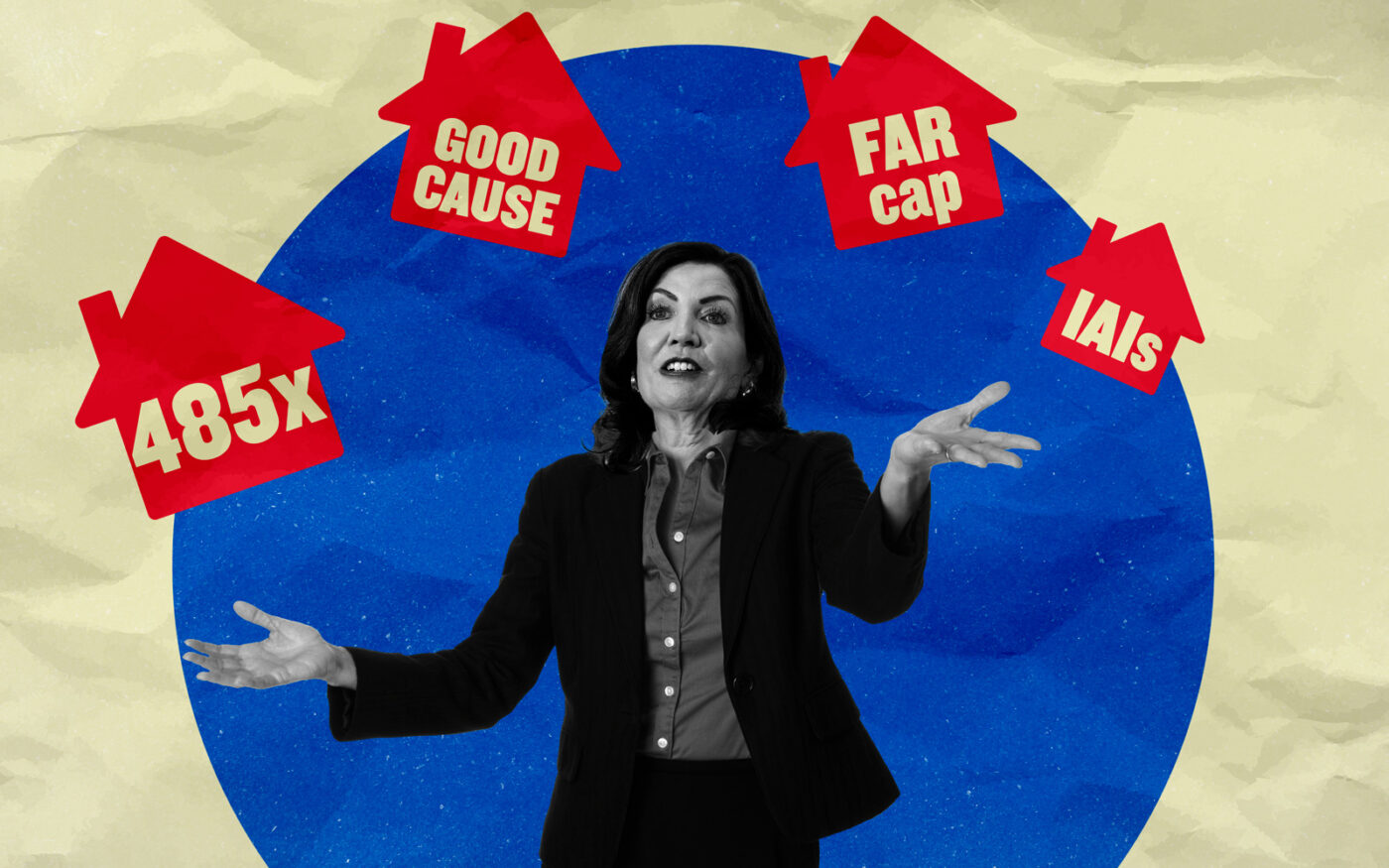State lawmakers brought back a property tax break, added tenant protections, encouraged office-to-residential conversions and changed renovation rules for rent-stabilized apartments — all in one monster budget bill.
The legislation brings together housing policies debated for several years. It includes compromises criticized by both real estate and tenant groups.
Owners called measures for rent-stabilized apartments and multifamily projects inadequate. Their counterparts argued that tenant protections were too watered down, resulting in a lopsided legislative package that favors developers and landlords.
Gov. Kathy Hochul, who negotiated the deal, and Mayor Eric Adams, who advocated for it, praised the outcome for its policies to increase housing production while enhancing tenants’ rights.
“I wasn’t here to please people. I’m here to help New Yorkers get a home.”
“There are, of course, voices who are not thrilled,” Hochul told WNYC’s Brian Lehrer this week. “But you know what, I wasn’t here to please people. I’m here to help New Yorkers get a home.”
The bill was expected to be approved by the legislature Saturday and signed by the governor. Here is a breakdown of the various housing policies included:
485x (formerly 421a)
Nearly two years after legislators defiantly let the multifamily project tax break 421a lapse, the state is replacing it with 485x, or Affordable Neighborhoods for New Yorkers. It increases affordability requirements for tenants and wages for workers on projects that receive the tax benefit.
The program gets rid of the highest-income option of the expired program, which had allowed developers to satisfy affordability requirements by setting aside 30 percent of apartments for households earning up to 130 percent of the area median income.
The new program provides an up to 40-year exemption on taxes, up from 35 years, and requires that the income-restricted units remain permanently affordable. The legislature is giving the program a longer runway than previous versions had: It expires June 15, 2034.
More details on 485x:
- Wages: After the Real Estate Board of New York and the Building and Construction Trades Council failed to come to terms on wages, lawmakers went with a middle-ground option that will keep accountants busy for years to come.
- Wage requirements kick in for any project with more than 100 units. For those, the wage and benefit floor starts at $40 per hour and increases 2.5 percent each year.
- At projects of 150 or more units in Manhattan south of 96th Street and on the Brooklyn and Queens waterfronts, including Williamsburg, Greenpoint and Long Island City (known as zone A), construction workers’ total compensation must be the lesser of $72.45 per hour or 65 percent of the prevailing wage.
- Contractors on such projects in zone B, which consists of other parts of Brooklyn (including Dumbo and Brooklyn Heights) and Queens (Astoria and Queensbridge), must pay at least $63 per hour or 60 percent of the prevailing rate.
- Those rates also increase 2.5 percent each year — an attempt by the legislature and governor to keep up with inflation.
- Affordability: Projects with more than 100 apartments must set aside 25 percent of units for tenants earning a weighted average of no more than 80 percent of the area median income. For projects with 150 units or more that are within zone A or B, the AMI number is 60 percent. Developments with six to 99 units must do 20 percent at 80 percent of AMI. Projects outside Manhattan that are 12,500 square feet or smaller and have six to 11 units are eligible for a 10-year benefit, and must make at least 50 percent of units rent-stabilized. Condo and co-op projects are also eligible, if they are located outside Manhattan and have an average assessed value of $89 per square foot or less. Condos had been part of 421a before being virtually excluded by the version that expired in 2022.
- Construction deadline: The budget extends the construction deadline for the expired 421a program. That means developers who managed to get foundation footings in the ground before June 15, 2022, have until June 2031 to finish.
- The takeaway: Lawmakers tried to strike a balance between wages and affordability. REBNY predicted the program will not create as much housing as 421a. But the industry needed something passed, because high property taxes on rentals had made new projects all but impossible to finance.
Office conversions
Last year, Mayor Eric Adams estimated that some 20,000 homes could be created within 10 years by converting office buildings to residences.
That projection relied on changes by the city and state, including lifting the citywide cap on residential floor area ratio, or FAR, as well as a new tax incentive so more of these costly and complicated projects would pencil out.
Terms of the conversion measure:
- Twenty-five percent of the new apartments must be affordable at a weighted average of 80 percent of the AMI, including 5 percent at 40 percent of the AMI.
- The length of the benefit ranges from 25 to 35 years, depending on when the application is filed. The exemption, generally, starts at 90 percent off the tax bill in areas of Manhattan south of 96th Street, and at 65 percent outside Manhattan. For any project, the tax break phases out in its final years.
FAR, a long, long way to go
For years, the idea of letting the city control its own residential density failed to gain traction in Albany. The new deal lifts the FAR cap, which had limited residential space to 12 times the lot size.
Lifting the cap does not automatically allow larger apartment buildings, but allows the city to rezone for them. The Adams administration’s proposed City of Yes for Housing Opportunity aims to create two residential districts with a FAR of 15 and 18.
Rezoning triggers the city’s Mandatory Inclusionary Housing law. The budget specifies that any residential projects that exceed an FAR of 12 must have at least as much affordable housing as is required under that law.
The budget also bars larger residential projects in historical districts or those that share a lot with a building containing joint living-work quarters for artists — an apparent concession to preservationists in neighborhoods such as Greenwich Village.
If a developer wants to demolish a residential building to take advantage of the higher FAR, tenants must be offered buyouts worth up to six months of rent, or a new lease in a comparable unit.
A different good cause
A “good cause eviction” bill introduced in 2019 would have allowed tenants to challenge evictions that resulted from rent increases of more than 3 percent or 1.5 times the regional inflation rate, whichever is higher. But it never came to a vote.
This year’s housing package instead implements a version of good cause similar to California’s:
- Tenants can challenge evictions resulting from rent increases greater than 10 percent, or 5 percent plus inflation, whichever is less.
- The policy automatically applies in New York City. Localities outside the city can opt in.
- Buildings constructed in 2009 or later are exempt from good cause for 30 years from the time of completion. Apartments affordable to households earning 245 percent of the area median income are also exempt, as are those whose owners have small portfolios, defined as no more than 10 units in the state. Owner-occupied buildings with 10 or fewer apartments are also exempt.
- Landlords can still evict tenants for failing to pay rent or for being a nuisance.
- The takeaway: Proponents of good cause warned that the carve-outs will exclude hundreds of thousands of tenants. They also worried about landlords gaming the portfolio-size exemption. Housing Justice for All urged lawmakers to reject the deal.
Time will tell if the compromise takes the issue off the table for landlords or establishes a benefit for tenants that future legislatures will enhance.
The policy has the same sunset date as 485x, meaning that these two issues will likely be pitted against each other again in 2034. A similar dynamic previously existed between the state’s rent stabilization system and 421a, until they were decoupled in 2019, when the rent law was made permanent.
Social housing
In their one-house budget resolutions, both the Senate and Assembly pitched programs that would help fund the development of limited equity co-ops on state-owned land.
The budget includes one that seems closer to the Assembly’s proposal — a program overseen by the state’s housing agency to fund limited-equity co-ops on land owned by the state, localities, nonprofits or community land trusts. It is called “New York Housing for Future Homeownership and Rental Housing.”
Basement apartments pilot
State and city lawmakers have long debated ways to legalize the tens of thousands of illegal basement and cellar apartments in the city. The issue gained urgency when 11 people were killed by Hurricane Ida’s floodwaters pouring into their homes.
State lawmakers have been reluctant to legalize such apartments or to even grant the city the authority to do so. This year, they agreed to let the city create a pilot program guided by “local involvement.”
The pilot program would allow basement and cellar apartments to be converted into legal units in 15 of the city’s 59 community districts: four each in the Bronx and Brooklyn, six in Manhattan and one in Queens. Community boards will have a chance to weigh in on joining the pilot program, but it seems likely that the local City Council member will ultimately decide.
Individual apartment improvements
In 2019, the state legislature made significant changes to rent stabilization. One was a restriction on the Individual Apartment Improvements program, which allowed landlords to increase rents on stabilized apartments after renovations.
Under the previous law, 1/40 of the cost of an apartment upgrade could be permanently added to the rent, and there was no limit to how much a landlord could spend. The 2019 law capped recoverable costs at $15,000 over 15 years, and limited the rent increase to 1/168 of the repair costs for smaller buildings and 1/180 for larger ones.
The new bill moves the numbers a bit in the direction of the old law.
- Apartment repairs eligible for rent bumps are limited to $30,000 over 15 years, with the rent increasing by 1/180 of the cost for buildings with more than 35 units and 1/168 for smaller buildings. Increases will be permanent and amount to $166 or $179 per month.
- The cost of repairs can go up to $50,000 if a unit were continuously occupied for 25 years or registered as vacant in 2022, 2023 and 2024. In those cases, owners of buildings with fewer than 35 units can hike the improved unit’s rent by 1/144 of $50,000, or $347 per month. In buildings with more than 35 units, the increase can be 1/156 of the renovation cost.
- The takeaway: The Rent Stabilization Association and Community Housing Improvement Program said the changes are not enough help for owners of distressed stabilized properties. Tenant groups described them as a dangerous rollback of the 2019 rent law.
CHIP had pushed for a separate measure to let landlords reset rents once on vacant stabilized apartments that had been occupied continuously for 10 or more years. The apartments would remain regulated. The bill has not come close to passing.
Squatters
Lawmakers in recent months responded to a surge in news stories about squatters by proposing a number of changes to state law.
The budget includes a measure closest to Queens Sen. John Liu’s bill, which changes a section of state law to explicitly exclude squatters — those who intrude or otherwise enter a property and continue to occupy it without permission — from the definition of a tenant. Another section of state law already specifies that a squatter does not have a landlord-tenant relationship.
The budget does not include a proposal to create a state-based voucher program, despite support from landlord and tenant groups. Also missing is the Faith-based Affordable Housing Act, which would have made it easier for religious organizations to build affordable housing on their property.
Read more



